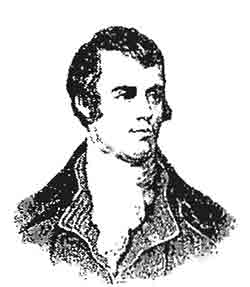The Harland & Wolff monument to Burns

Jim Heron
Robert Burns met young Mary Campbell during the early spring of 1786. Burns at this time was an unpublished poet and virtually unknown outside his own village of Mauchline. Mary, on the other hand, had left her home in the West Highlands to take up a position of nursemaid in the home of Burns’s good friend and landlord Gavin Hamilton.
It is not known whether they met at Hamilton’s house or Mauchline Parish Church, where they both worshipped. What is known, however, is that they both embarked on a whirlwind romance that was to end in deep tragedy. During the middle of May they met at a pre-arranged spot on a little hill by the side of Failford village where they planned what must have seemed an uncertain future. Their plans included marriage and emigration to the West Indies.
Will ye go to the Indies my Mary
And leave old Scotia’s shore?
Will ye go to the Indies my Mary,
Across the Atlantic roar?
Before they left the hill they pledged to meet up again in the autumn, and when they embraced little did they realise it was to be for the last time. Mary was off to her parents’ home in Campbeltown to say farewell to family and friends, while Burns returned to the farm to put his affairs in order before meeting up again with Mary.
As Burns awaited Mary’s return, his first book of poetry was published in Kilmarnock and shocked everyone by taking Scotland by storm. Indeed, it was to project Burns virtually overnight from common young farmer to literary genius. But from the euphoria of his newly-found fame, Burns was to be plunged into the depths of despair.
Mary, her final farewells said, set off to meet Burns, but stopped off to visit an uncle in Greenock and while there caught a malignant fever that was to take her life within forty-eight hours. Because of the danger of infection, she was buried immediately in a local churchyard down near the water’s edge. She was twenty three. Burns was devastated.
See’st thou thy lover lowly laid
Hear’st thou the groans that rend his breast?
Our story now moves on to the year 1919. This was during the era of great ships and equally great shipbuilders, with none greater than Harland & Wolff of Belfast. With a massive order book and massive workforce, the company decided to purchase an additional yard, and the one they chose was Cardie & Co. on the Clyde.
The new yard, however, lacked a suitable graving dock and fitting out basin, so Harland & Wolff immediately embarked on a large expansion and modernisation plan, but found an old derelict church and graveyard in their way; so the company sought permission to have the site levelled and the remains from the old graves buried in another part of the town. However, it was then discovered that one of these graves contained the remains of Highland Mary Campbell, and the thoughts of disturbing her grave sent shock waves not only through Scotland but the entire Burns world. Protest meetings were held and questions raised at Westminster, but commerce was to triumph over sentiment and Harland & Wolff were given permission.
Mary’s bones were lifted and put into a new casket. A huge crowd gathered as relays from local Burns Clubs carried the coffin the two miles to her new place of rest, and as Mary was laid in the grave the rain began to fall gently.
At the head of the mourners stood Lord Pirrie, Managing Director of Harland & Wolff, and at an appropriate time he stepped forward and on behalf of the company laid a huge wreath of white lilies.
William Pirrie was born in Quebec in 1847 to a County Down family, and after returning to Ulster was educated at Belfast Academical Institution. He was an apprentice in Harland & Wolff in 1862 but by 1874 had become a partner and later Chairman. He also instigated the innovation in design which led to the building of large liners and was also to become Lord Mayor of Belfast in 1896.
Lord Pirrie was however first and foremost a hard-bitten businessman, but even he had pangs of conscience at disturbing Mary’s grave, so at a board meeting he persuaded the company to donate a sizeable sum of money to the Burns Federation on the understanding that it would be used for the sole purpose of building a monument to Burns and Highland Mary.
The Burns Federation thought long and hard, chose well, and on the second week in May 1922 a monument was erected on Failford hill — the last meeting place of the young lovers. The monument is a sandstone obelisk fifteen feet high and surrounded by a stout railing. Inscribed is the story of Burns and Mary, but at the base one can clearly read: “This stone was erected by the Burns Federation with money kindly donated by Harland & Wolff shipyards.”

